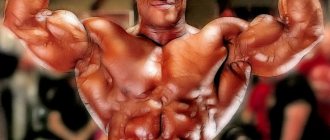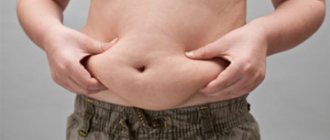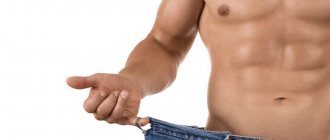The accumulation of subcutaneous fat (among other factors) is influenced by sex hormones - testosterone in men and estrogen in women. At the same time, high estrogen levels are most often associated with fat storage in the buttocks and thighs, while a lack of testosterone in men is associated with abdominal growth¹.
Although it is impossible to lose weight in a strictly defined area (for example, in the legs or thighs), and excess weight tends to be burned evenly from the entire body, you can try to understand what factors provoked the deposition of fat on the legs. Which, among other things, is influenced by a person’s age.
Doomed to obesity?
Are most women doomed to be obese? For many women, a high number of fat cells in the thigh area is indeed genetic. However, regardless of their number, these cells can shrink. You can actually lose significant weight. But if you have a genetic predisposition to weight gain, losing weight may be more difficult for you than for others. In this case, you should immediately prepare for the fact that losing weight will require additional time and effort.
If you really want to have a slim body with proportional hips and are willing to approach this difficult problem realistically, without looking for easy solutions, nothing will stop you on this path - you are not doomed to obesity.
1358 5
Pregnancy
Of course, pregnancy leads to weight gain. Research shows that the average woman gains 12.5 kg during the last third of her pregnancy. Moreover, 20% of this weight falls on adipose tissue. Progesterone levels remain high throughout pregnancy. Instead of making you feel hungry periodically, this hormone continuously stimulates your appetite for 9 months.
However, progesterone is not the actual culprit behind pregnancy weight gain. Responsibility for this process lies with fat cells, the number of which rapidly increases during infancy, puberty and pregnancy. In addition, when men and women gain weight quickly, the number of fat cells increases. However, during pregnancy, women do have a significant chance of becoming obese.
The number of fat cells produced depends on how quickly and how much weight you gain. Once formed, fat cells remain with you for the rest of your life, constantly requiring nutrition. It is for this reason that most of the fat tissue formed during pregnancy remains after the birth of the child.
Voluminous buttocks and wide, massive hips simplify the process of childbearing. The proportion of fat is usually located in the upper thighs. Many women with these qualities experience fewer problems during childbirth than women with narrow hips and flat buttocks.
Puberty
In childhood, both sexes have minimal differences in the volume of adipose tissue. However, during puberty, girls begin to accumulate fat, while boys develop muscle mass. Before the onset of menstruation, adipose tissue in girls' bodies should account for 15% to 20% of their body weight.
Low body fat percentage causes athletic girls who participate in gymnastics, dance or track and field to begin menstruating several years later than their peers who are less active. It is often necessary to reduce the amount of physical activity to allow fat tissue to form normally, which in turn activates hormonal balance and leads to the onset of regular menstrual cycles.
Causes of female-type obesity in men
Obesity in men of the female type has different causes and treatment. Under normal conditions, the body maintains normal concentrations of estrogen and androgens. Testosterone is responsible for building the muscles that form a male figure, and estrogen is so small that it does not have a noticeable effect on the formation of fat deposits like a female figure.
When a hormonal imbalance occurs, as a result of which the level of estrogen begins to prevail over the concentration of testosterone, a man’s potency decreases, and fat begins to be deposited on the buttocks and thighs. Fat deposits can also form on the chest. Thus, when female-type obesity occurs in men, treatment involves, first of all, normalizing hormonal levels.
Other causes of pathological fat deposition on the male body include the following:
- mental disorders;
- lack of mobility;
- improper diet and nutrition;
- poor environmental situation.
All of them usually aggravate the situation with hormonal imbalances. There is another reason for female-type obesity in men - the use of steroid drugs for bodybuilding. It is quite rare and is caused by an incorrect approach to the use of drugs that affect testosterone production.
Birth control pills
Birth control pills are still the most popular form of contraception. There are different types of these pills, but the most popular is a combination of synthesized estrogen and progesterone.
Just 10 years ago, the average woman taking birth control pills gained approximately 1.4 to 2.3 kg of weight as a side effect of the pill. Most of this weight was accounted for by fat tissue. The synthesized hormones acted in the same way as natural ones. They stimulated the formation of fat. Fortunately, many modern birth control pills contain less estrogen and progesterone than before and, as a result, are less likely to cause weight gain.
How to make your buttocks smaller?
Proper nutrition
Of course, you need to start with proper nutrition. As a rule, men do not like to deny themselves anything, especially tasty food. But, if you still set a goal for yourself, then under no circumstances deviate from it. Remove all harmful foods: fatty, fried, smoked, canned. Fast food, hamburgers and greasy wings should be a thing of the past. All sweet drinks, including sparkling water, remain there. So, we are halfway to success.
We include fiber in the diet (if the goal is elastic, sculpted, beautiful male buttocks). It will improve the functioning of the digestive tract, speed up metabolism, and remove toxins and waste. To do this, we eat more vegetables (broccoli, zucchini, eggplant, cabbage, celery, etc.), and take a portion of cereals or muesli for breakfast. The sports store has a huge selection of tasty additives that will help make breakfast tastier (syrups, sauces, nutritional supplements), as well as various types of fiber (apple fiber, inulin, bran) and a huge number of dishes to choose from: noodles, rice, spaghetti.
Don't completely exclude sweets: honey and dried fruits are an excellent alternative to sweets and chocolate. Gradually reduce the percentage of carbohydrates consumed and increase protein intake. You can use protein shakes as a snack and eat casein desserts at night.
Drink more water. This is one of the best fat burners in nature. There should be at least 30 ml of water per 1 kg of human body.
Physical exercise
In order for the buttocks to become smaller and at the same time attractive, an integrated approach is needed, including regular aerobic exercise, general strengthening and isolated exercises.
For aerobic exercise, it is best to use interval training. One minute you run as if you were being chased by a pack of rabid wolves, and then for three minutes you walk at a calm pace. Do a separate cardio workout. This can be an exercise bike, swimming, running, boxing, but not less than an hour.
When doing strength exercises, focus on your lower body. Your training plan must include squats, lunges, and the “glute bridge” exercise. In any case, an experienced trainer will always help you create a competent program to reduce your buttocks. At the same time, the muscles of the whole body will become toned. Do at least 20 repetitions for 4 sets.
If you study at home, try to keep your classes regular. Buy all the necessary accessories (mat, dumbbells, barbell) or use improvised means, the main thing is to work on yourself! Do a warm-up and cool-down every time, don’t feel sorry for yourself.











